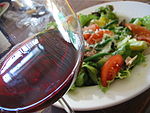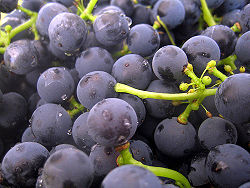
Carbonic maceration
Encyclopedia

Winemaking
Winemaking, or vinification, is the production of wine, starting with selection of the grapes or other produce and ending with bottling the finished wine. Although most wine is made from grapes, it may also be made from other fruit or non-toxic plant material...
technique, often associated with the French wine
French wine
French wine is produced in several regions throughout France, in quantities between 50 and 60 million hectolitres per year, or 7–8 billion bottles. France has the world's second-largest total vineyard area, behind Spain, and is in the position of being the world's largest wine producer...
region of Beaujolais
Beaujolais
Beaujolais is a French Appellation d'Origine Contrôlée wine generally made of the Gamay grape which has a thin skin and is low in tannins. Like most AOC wines they are not labeled varietally. Whites from the region, which make up only 1% of its production, are made mostly with Chardonnay grapes...
, in which whole grapes are fermented
Fermentation (wine)
The process of fermentation in wine turns grape juice into an alcoholic beverage. During fermentation, yeast interact with sugars in the juice to create ethanol, commonly known as ethyl alcohol, and carbon dioxide...
in a carbon dioxide
Carbon dioxide
Carbon dioxide is a naturally occurring chemical compound composed of two oxygen atoms covalently bonded to a single carbon atom...
rich environment prior to crushing. Conventional alcoholic fermentation
Ethanol fermentation
Ethanol fermentation, also referred to as alcoholic fermentation, is a biological process in which sugars such as glucose, fructose, and sucrose are converted into cellular energy and thereby produce ethanol and carbon dioxide as metabolic waste products...
involves crushing the grapes to free the juice and pulp from the skin with yeast
Yeast
Yeasts are eukaryotic micro-organisms classified in the kingdom Fungi, with 1,500 species currently described estimated to be only 1% of all fungal species. Most reproduce asexually by mitosis, and many do so by an asymmetric division process called budding...
s serving to convert sugar
Sugar
Sugar is a class of edible crystalline carbohydrates, mainly sucrose, lactose, and fructose, characterized by a sweet flavor.Sucrose in its refined form primarily comes from sugar cane and sugar beet...
into ethanol
Ethanol
Ethanol, also called ethyl alcohol, pure alcohol, grain alcohol, or drinking alcohol, is a volatile, flammable, colorless liquid. It is a psychoactive drug and one of the oldest recreational drugs. Best known as the type of alcohol found in alcoholic beverages, it is also used in thermometers, as a...
. Carbonic maceration ferments most of the juice while it is still inside the grape, although grapes at the bottom of the vessel are crushed by gravity and undergo conventional fermentation. The resulting wine
Wine
Wine is an alcoholic beverage, made of fermented fruit juice, usually from grapes. The natural chemical balance of grapes lets them ferment without the addition of sugars, acids, enzymes, or other nutrients. Grape wine is produced by fermenting crushed grapes using various types of yeast. Yeast...
is fruity with very low tannins. It is ready to drink quickly but lacks the structure for long-term aging. In the most extreme case, such as with Beaujolais nouveau
Beaujolais nouveau
Beaujolais nouveau is a red wine made from Gamay grapes produced in the Beaujolais region of France. It is the most popular vin de primeur, fermented for just a few weeks before being released for sale on the third Thursday of November...
, the period between picking and bottling can be less than six weeks.
Process
During carbonic maceration, an anaerobic environment is created by pumping carbon dioxide into a sealed container filled with whole grape clusters. The carbon dioxide gas permeates through the grape skins and begins to stimulate fermentation at an intracellularIntracellular
Not to be confused with intercellular, meaning "between cells".In cell biology, molecular biology and related fields, the word intracellular means "inside the cell".It is used in contrast to extracellular...
level. The entire process takes place inside each single, intact berry. Ethanol is produced as a by-product of this process but studies have shown that other unique chemical reactions take place that have a distinctive effect on the wine.
History
The process of carbonic maceration occurs naturally in a partial state without deliberate intervention and has occurred in some form throughout history. If grapes are stored in a closed container, such as an oak barrel, the force of gravity will crush the grapes on the bottom, releasing grape juice. Ambient yeasts present on the grape skins will interact with the sugars in the grape juice to start conventional ethanol fermentation. Carbon dioxide is released as a by product and, being denser than oxygenOxygen
Oxygen is the element with atomic number 8 and represented by the symbol O. Its name derives from the Greek roots ὀξύς and -γενής , because at the time of naming, it was mistakenly thought that all acids required oxygen in their composition...
, will push out the oxygen through any permeable surface (such as slight gaps between wood planks) creating a mostly anaerobic environment for the uncrushed grape clusters to go through carbonic maceration. Some of the earliest documented studies on the process was conducted by the French scientist Louis Pasteur
Louis Pasteur
Louis Pasteur was a French chemist and microbiologist born in Dole. He is remembered for his remarkable breakthroughs in the causes and preventions of diseases. His discoveries reduced mortality from puerperal fever, and he created the first vaccine for rabies and anthrax. His experiments...
who noted in 1872 that grapes contained in an oxygen rich environment prior to crushing and fermentation produced wines of different flavors than grapes produced in a carbon dioxide rich environment. This was because the fermentation process had already started within the individual grape clusters prior to the introduction of yeasts during conventional fermentation.
Wine production

Beaujolais nouveau
Beaujolais nouveau is a red wine made from Gamay grapes produced in the Beaujolais region of France. It is the most popular vin de primeur, fermented for just a few weeks before being released for sale on the third Thursday of November...
wine from the Gamay
Gamay
Gamay is a purple-colored grape variety used to make red wines, most notably grown in Beaujolais and in the Loire Valley around Tours. Its full name is Gamay Noir à Jus Blanc. It is a very old cultivar, mentioned as long ago as the 15th century...
grape in the Beaujolais region. This grape lends itself well to the production of simple, fruity wines and Beaujolais winemakers have been able to create a unique identity based on this distinctive style of wine.
Producers in other parts of France
France
The French Republic , The French Republic , The French Republic , (commonly known as France , is a unitary semi-presidential republic in Western Europe with several overseas territories and islands located on other continents and in the Indian, Pacific, and Atlantic oceans. Metropolitan France...
and in the New World
New World wine
New World wines are those wines produced outside the traditional wine-growing areas of Europe, in particular from Argentina, Australia, Canada, Chile, New Zealand, South Africa and the United States.-Early wines in the Americas:...
have frequently utilized carbonic maceration for their own Gamay production, or with other grape varieties. Winemakers in the Languedoc
Languedoc wine
Languedoc - Roussillon wine, including the vin de pays labeled Vin de Pays d'Oc, is produced in southern France. While "Languedoc" can refer to a specific historic region of France and Northern Catalonia, usage since the 20th century has primarily referred to the northern part of the...
and Rhône wine regions will sometimes employ the technique on coarse and tannic grapes like Carignan, especially if they are to be blended with other varieties. In California, the process is sometimes used with Valdiguié grapes, producing what is labeled a "Nouveau
Nouveau
A nouveau, or vin primeur, is a French wine which may, under the Appellation d'origine contrôlée regulations, be sold in the same year in which it was harvested. The most widely exported nouveau wine is Beaujolais nouveau which is released on the third Thursday of November, often only a few weeks...
" wine.
The process is almost always used in conjunction with red wine production since some of the flavors compounds produced by volatile phenols tend to form undesirable flavors with white wine grape varieties.
Other techniques
Semi-carbonic maceration is the winemaking technique where grapes are put through a short period of carbonic maceration, followed by conventional yeast fermentations. This is the process used in the production of Beaujolais nouveau wines. To an extent, most wines were historically treated to some form of semi or partial carbonic fermentation (as noted in history section above) with the amount dependent on the shape and size of the vessel that the grapes were stored in prior to crushing. The deeper the vessel, the greater the proportion of grapes that could be exposed to an anaerobic environment caused by the release of carbon dioxide from the crushed grapes on the bottom.An alternative name for carbonic maceration is "whole grape fermentation" which is distinct from the process known as "whole bunch fermentation" which is common in the Burgundy wine
Burgundy wine
Burgundy wine is wine made in the Burgundy region in eastern France, in the valleys and slopes west of the Saône River, a tributary of the Rhône. The most famous wines produced here - those commonly referred to as "Burgundies" - are red wines made from Pinot Noir grapes or white wines made from...
production of Pinot noir
Pinot Noir
Pinot noir is a black wine grape variety of the species Vitis vinifera. The name may also refer to wines created predominantly from Pinot noir grapes...
. With "whole bunch fermentation", entire clusters of grapes (including stems) are fermented before being crushed. This creates a large "cap" of grape skins with pathways created by the stems that allows juice to flow more evenly through caps, increasing the levels of skin contact or maceration
Maceration (wine)
Maceration is the winemaking process where the phenolic materials of the grape— tannins, coloring agents and flavor compounds— are leached from the grape skins, seeds and stems into the must. Maceration is the process by which the red wine receives its red color, since 99% of all grape juice is...
.

